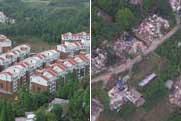China
China´s first moon orbiter launch in sight
Source: Xinhuanet | 10-24-2007 09:07
Special Report: Chang'e I -Journey to the Moon |
Visitors walk past Long March III carrier rocket at the Xichang Satellite Launch Center (XSLC) located in Southwest China's Sichuan Province Oct. 18, 2007. The country's first moon orbiter, Chang'e I, is set to be launched on Oct. 24. (Photo: China Daily)
XICHANG, Sichuan, Oct. 23 (Xinhua) -- China is busy preparing for the launch of its first moon orbiter which is likely to take place on Wednesday evening.
The rocket is now on the launch pad and all staff are in position at the site.
The preparations for the launch of the circumlunar satellite named Chang'e I are almost complete, according to a spokesman from the Xichang Satellite Launch Center in southwest China's Sichuan Province.
The weather forecasters say that over the next few days conditions will be suitable for the launch, the source said.
The satellite, which was shipped to the launch center two months ago, and the carrier Long March 3A, set in place a month ago, have undergone all pre-launch tests and several examinations, he said.
The satellite will be launched between October 24 and 26 and the first choice is around 6:00 p.m. on October 24, said a spokesman for the China National Space Administration (CNSA) Monday.
Two hours before the launch, residents living within 2.5 km of the launch center and under the trajectory of the carrier will be evacuated, the Xichang Satellite Launch Center said.
The number of people to be evacuated will be several thousand, it said.
"The evacuation is part of our code for the satellite launch," said an official with the launch center.
The circumlunar satellite, named Chang'e I after the legendary Chinese goddess who was said to fly to the moon, is expected to enter earth-moon transfer orbit on October 31 and arrive in the moon's orbit on November 5.
The satellite will relay the first picture of the moon in late November and will then continue scientific explorations of the moon for a year.
Editor:Du Xiaodan



